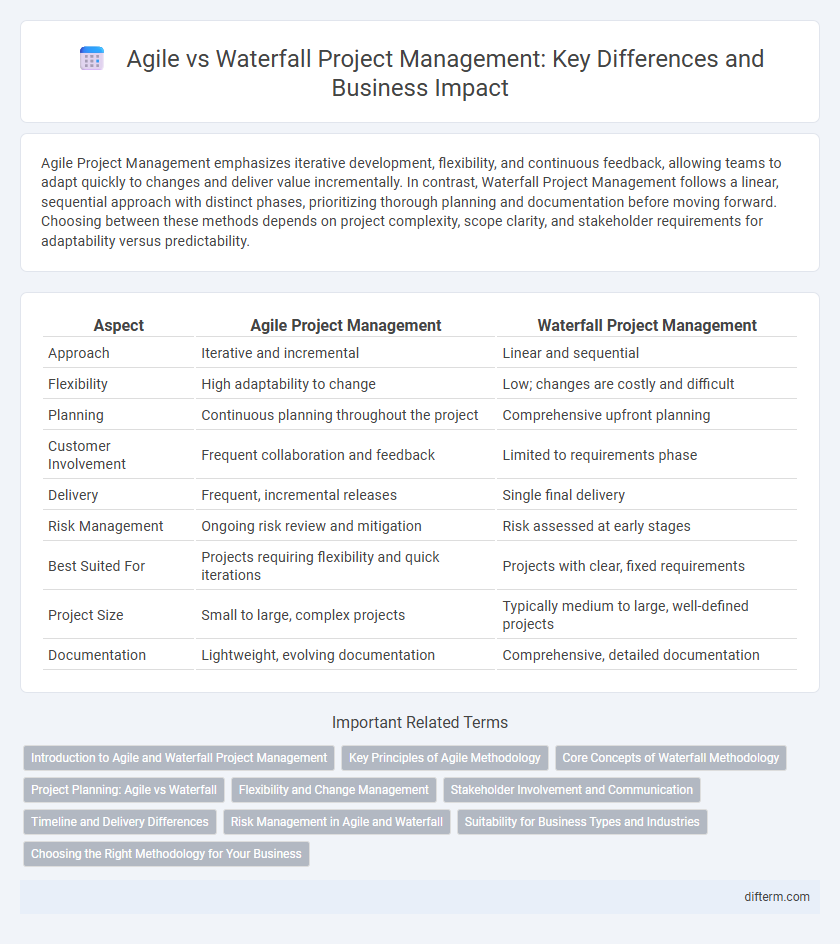Agile Project Management emphasizes iterative development, flexibility, and continuous feedback, allowing teams to adapt quickly to changes and deliver value incrementally. In contrast, Waterfall Project Management follows a linear, sequential approach with distinct phases, prioritizing thorough planning and documentation before moving forward. Choosing between these methods depends on project complexity, scope clarity, and stakeholder requirements for adaptability versus predictability.
Table of Comparison
| Aspect | Agile Project Management | Waterfall Project Management |
|---|---|---|
| Approach | Iterative and incremental | Linear and sequential |
| Flexibility | High adaptability to change | Low; changes are costly and difficult |
| Planning | Continuous planning throughout the project | Comprehensive upfront planning |
| Customer Involvement | Frequent collaboration and feedback | Limited to requirements phase |
| Delivery | Frequent, incremental releases | Single final delivery |
| Risk Management | Ongoing risk review and mitigation | Risk assessed at early stages |
| Best Suited For | Projects requiring flexibility and quick iterations | Projects with clear, fixed requirements |
| Project Size | Small to large, complex projects | Typically medium to large, well-defined projects |
| Documentation | Lightweight, evolving documentation | Comprehensive, detailed documentation |
Introduction to Agile and Waterfall Project Management
Agile Project Management emphasizes iterative development, continuous feedback, and flexibility to adapt to changing project requirements, fostering collaboration among cross-functional teams. Waterfall Project Management follows a linear, sequential approach with distinct phases such as planning, execution, and testing, prioritizing thorough documentation and upfront planning. Choosing between Agile and Waterfall depends on project complexity, stakeholder involvement, and the need for adaptability versus predictability.
Key Principles of Agile Methodology
Agile Project Management emphasizes iterative development, customer collaboration, and flexibility to adapt to changing requirements throughout the project lifecycle. Key principles include delivering working software frequently, maintaining close communication with stakeholders, and empowering self-organizing teams to improve productivity and innovation. This methodology contrasts with Waterfall's linear, phase-based approach by promoting continuous feedback and incremental progress for faster value delivery.
Core Concepts of Waterfall Methodology
Waterfall Project Management follows a linear, sequential approach where each phase flows downward through requirements, design, implementation, testing, and maintenance, ensuring clear documentation and defined deliverables at each stage. This methodology emphasizes a structured timeline with fixed scope, making it well-suited for projects with stable requirements and predictable outcomes. Its core concepts include thorough upfront planning, milestone-driven progress, and limited client involvement during execution, contrasting with Agile's iterative and flexible processes.
Project Planning: Agile vs Waterfall
Agile project management emphasizes iterative planning with flexible scope adjustments, promoting continuous stakeholder collaboration and rapid adaptation to change. Waterfall project management follows a linear, sequential approach where detailed project planning is completed upfront, establishing fixed scope, timelines, and deliverables. Agile's adaptive planning suits dynamic environments, while Waterfall's structured planning benefits projects with clearly defined requirements.
Flexibility and Change Management
Agile project management offers superior flexibility by embracing iterative development and continuous feedback, enabling teams to adapt rapidly to changing requirements and market conditions. In contrast, Waterfall project management follows a linear, sequential approach with rigid phases, making change management more challenging and often costly once the project is underway. Agile's incremental delivery allows for early detection of issues and quicker adjustments, whereas Waterfall's fixed structure limits responsiveness to evolving project needs.
Stakeholder Involvement and Communication
Agile Project Management emphasizes continuous stakeholder involvement and frequent communication through iterative cycles, enabling rapid feedback and adaptive changes that align with evolving project needs. In contrast, Waterfall Project Management typically involves stakeholders primarily during initial planning and final delivery phases, resulting in limited ongoing engagement and fewer opportunities for mid-project adjustments. Effective communication in Agile fosters collaboration and transparency, while Waterfall's structured approach can lead to delayed stakeholder input and less responsiveness to change.
Timeline and Delivery Differences
Agile Project Management emphasizes iterative development with flexible timelines, promoting frequent delivery of small, functional product increments that adapt to changing requirements. Waterfall Project Management follows a linear, sequential timeline where each phase must be completed before the next begins, resulting in a single final delivery after all project stages are finished. The Agile approach enhances responsiveness and continuous delivery, while Waterfall ensures strict adherence to initial scope and deadlines, which can impact flexibility in timeline adjustments.
Risk Management in Agile and Waterfall
Agile Project Management mitigates risk through iterative development, continuous feedback, and adaptive planning, allowing teams to identify and address issues early in the project lifecycle. Waterfall Project Management relies on upfront risk assessment and linear execution, which can lead to delayed risk detection and less flexibility in responding to changes. Agile's proactive risk management enhances project resilience, whereas Waterfall's structured approach suits projects with well-defined requirements and lower uncertainty.
Suitability for Business Types and Industries
Agile project management excels in dynamic, fast-paced industries such as software development, marketing, and startups where flexibility and iterative progress are critical. Waterfall project management suits industries with well-defined requirements and predictable processes, like construction, manufacturing, and government projects, emphasizing structured phases and documentation. Businesses in highly regulated sectors often prefer Waterfall for compliance, while innovative and rapidly evolving businesses benefit from Agile's adaptability and customer collaboration.
Choosing the Right Methodology for Your Business
Selecting the appropriate project management methodology hinges on your business's objectives, team dynamics, and the project's complexity. Agile Project Management suits businesses requiring flexibility, iterative progress, and rapid response to change, while Waterfall excels in environments with clear, fixed requirements and sequential phases. Evaluating project scope, stakeholder involvement, and risk tolerance ensures alignment with a methodology that maximizes efficiency and outcomes.
Agile Project Management vs Waterfall Project Management Infographic

 difterm.com
difterm.com